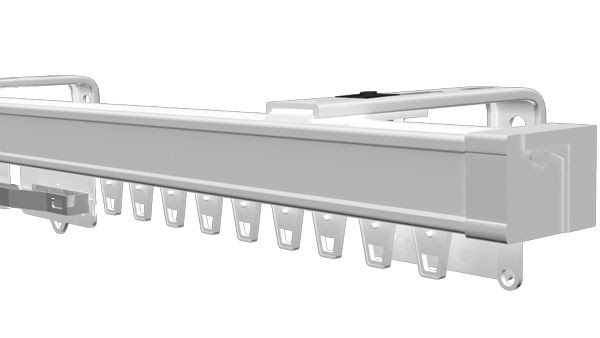
The Kirsch Architrac system supports the three most popular drapery heading styles—Ripplefold, pleated, and cubicle—and offers exceptional versatility for designers working on residential and commercial projects. In this video, Glen Tyson, MYL Hardware and Products Distribution Manager, and Jennifer DeRosa, MYL Drapery Department Manager, walk through the nuances of the Architrac line—clarifying which tracks to use when, how they install, and the key considerations for aesthetic and functional success.
02:41 – The 94001
22:00 – The 94004
24:46 – The 94005
27:10 – The K-Rail
Understanding Traverse Rods vs. Decorative Hardware
One of the most common points of confusion: the term “traverse rod.” Many clients envision a decorative pole with rings and a baton, but true traverse rods (like the Kirsch Architrac line) are track systems with carriers that allow drapes to open and close via cord, baton, motor, or hand-draw.
Choosing the Right Kirsch Architrac Series
Kirsch Architrac Series Overview
Series 94001 – Multi-Draw (Cord, Baton, or Motor)
- Use Case: Most versatile and the only motorized option in the Architrac line.
- Installation: Includes two-piece brackets (wall or ceiling mount). Installers can convert wall brackets to ceiling mount easily by separating the parts.
- Strength: Supports up to 4–5 lbs per foot—ideal for heavier drapes.
- Drape Compatibility: Works with pinch pleat and Ripplefold headers. Uses slim carriers to minimize stack back.
- Motorization Note: Kirsch motors mount behind the drape, preserving the full traversable width—no loss of stack space, unlike other brands.
- Ripplefold Tip: Ripplefold fullness comes from carrier spacing, not just fabric. Kirsch uses a consistent snap tape across all fullness levels, which means fabric yardage and drape construction vary.
Design Insight: Use overlap masters for blackout applications and butt masters when aesthetics and visual continuity are prioritized. Overlap masters may interrupt the front-to-back Ripplefold wave, while butt masters maintain the wave but can let light in if the drape separates.
Series 94003, 94004, and 94005 – Baton Draw System
- Use Case: Budget-friendly yet durable options for baton-draw installations (ideal for hospitality projects, hospitals, or multi-unit spaces).
- Design Differences:
- 94003: Versatile baton track with simple two-piece bracket system (installer favorite).
- 94004 (“F-Track”): Sleekest ceiling mount option. Mounts flush using pre-drilled holes—no brackets.
- 94005: Ceiling-mount only. Slightly taller profile (1″) with a minimalist look. Requires narrow-neck screwdriver due to tight screw access.
- Colors: Available in white, anodized (silver), bronze (dark), and black.
Note on Wear: Designers using pinch pleat on these tracks may choose to pin drapes lower to hide the track, but this could cause forward lean or fabric wear over time.
K-Rail – 1 3/8” Decorative System
The Kirsch K-Rail is a sleek hybrid—offering the simplicity of Architrac with the upscale feel of a decorative estate rod.
- Appearance: Seamlessly integrates a face-mounted fascia into the track body for a clean, finished look.
- Functionality: Baton-draw only.
- Finishes: White, anodized, bronze, and black (note: K-Rail bronze is lighter than standard Architrac bronze).
- Installation: Wall mount is simple. Ceiling mount requires a drop bracket to accommodate the top fascia and allow clearance for finials.
- Finial Compatibility: Accepts any 1 3/8″ finial—wood or metal. However, matching finishes (especially in white or bronze) may be limited.
- Optional End Cap: A streamlined plastic end cap is available when a finial isn’t used. While not an exact color match, it’s a close visual complement.
Key Takeaways
From low-profile cord draw tracks to sleek baton-draw options and decorative hybrids like K-Rail, Kirsch Architrac offers interior designers a complete toolkit for functional, beautiful drapery installations. When selecting a track system, consider:
- Mounting style (wall vs. ceiling)
- Desired drapery movement (motor, cord, baton)
- Header style and stack back requirements
- Client needs (blackout vs. aesthetic)
- Installer preferences and installation constraints
Every project is unique—and understanding these track systems empowers you to deliver the perfect combination of performance and polish.
Explore the full Kirsch hardware collection here.
